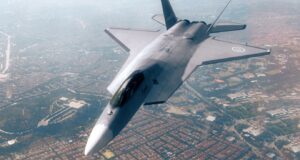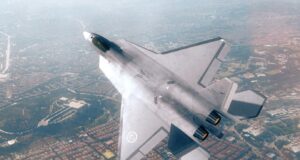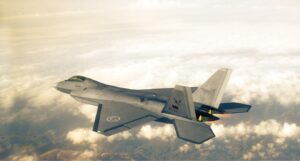Aerospace
Meet Turkey’s home built 5th gen fighter jet TF x : Specification, speed, Engine and Weapons

Welcome back to Jetline marvel. Meet Turkish Aerospace Industry’s TF X. It has a stealth twin engine and all-weather air superiority for the fifth generation. The F16 Fighting Falcons of the Turkish Air Force will be replaced with this aircraft, which will be exported to other countries. By March 2023, this aircraft will be unveiled, and it will take to the skies for the first time in 2025.
The TFX is a fifth-generation fighter that looks a lot like the F-35 Lightning II from Lockheed Martin. The indigenous planes will eventually replace the Turkish Air Force’s F-16 fighter jets, which are scheduled to be phased out by the 2030s.
Turkey will become one of the few countries having the technology, technical infrastructure, and capabilities to build a fifth-generation (or beyond) fighter plane.
TFX’s full-scale mock-up debut in Singapore could be geared towards identifying possible Asian partners. TAI has been working in the Asian market to strengthen collaborations in next-generation technologies, especially in the defence and aviation sectors.
The TF-X is the first 5th-generation aircraft to be designed and manufactured using digital twin technology. Until the TAEC engine is available, prototypes will be powered by General Electric F110 engines.
How has Boeing’s B787 dreamliner turned into a nightmare?
TF x has Upgraded versions of Aselsan’s own radar warning receiver, missile warning system, laser warning system, chaff and flare management would most likely be used on the aircraft. It has a dispensing system as well as a digital radio frequency memory-based jamming system, both of which have been employed on other air platforms.
The length of this aircraft is 21 meters, the wingspan is 14 meters, and the height is 6 meters.
The maximum take-off weight for this aircraft is projected to be 27,215kg.
For the test, it includes a power plant of two GE F110 engines, each capable of producing 120 kilo newton’s of thrust.
It has a top speed of 2,470 km/h, a combat range of up to 1,100 kilometers, and a service ceiling of 55,000 feet.
What is the Boeing P-8I in the Indian Navy used for?
It can carry a wide range of weapons. It has indigenously developed Goktug missiles and imported MBDA meteor air-to-air missiles.
It also has air-to-surface missiles such as the SOM cruise missile B1,2,3 and the indigenously developed Kuzgun TJ air-to-surface missile, as well as anti-radiation missiles, anti-ship, air-to-surface, cruise missiles, and the MBDA spear 3, as well as many other weapons to be added to the TF x aircraft.
Did you know these 10 incredible facts about Honda jet ?

Aerospace
Which is bigger 777x or 787 aircraft ?

The 777X is a new series of the Boeing 777 family and is designed to be larger and more efficient than its predecessor. It features two variants: the 777-8 and the 777-9, being the larger of the two.
The Boeing 777X emerges as the larger sibling within the Boeing family, representing a significant leap forward in both size and efficiency. Comprising two variants, the 777-8 and the 777-9, the latter takes the crown as the larger of the two. With its expansive fuselage and impressive wingspan, the 777X is tailored for long-range journeys and boasts a substantial passenger capacity.
On the other hand, the Boeing 787, affectionately known as the Dreamliner, occupies a niche in the market as a smaller yet formidable aircraft designed for medium to long-range flights. Its distinguishing feature lies in its composite fuselage, a technological marvel that renders it lighter and more fuel-efficient compared to conventional aluminum counterparts. The Boeing 777X is larger than the Boeing 787 aircraft.
When it comes to passenger capacity, the 777-9 reigns supreme, typically accommodating a sizeable contingent of 400-425 passengers in its standard configuration. In contrast, the 787, with its more modest dimensions, typically carries between 240-290 passengers, depending on the variant and layout.
One of the remarkable innovations introduced with the 777X is its folding wingtips, a feature designed to address the logistical challenges of accommodating such a large aircraft in conventional airport gates. These folding wingtips enable the 777X to retract its wings, allowing it to fit into gates designed for smaller aircraft while still reaping the benefits of an extended wingspan during flight, thereby enhancing fuel efficiency and operational flexibility
Aerospace
China Secures Production Certificate for Mass Production of Pilotless eVTOL Aircraft

The first passenger-carrying pilotless electric vertical takeoff and landing (eVTOL) aircraft in the world, the EH216-S, has received the Production Certificate for its eVTOL aircraft from the Civil Aviation Administration of China (CAAC).
This is a significant milestone for EHang Holdings Limited, the leading UAM technology platform company in the world. This outstanding accomplishment is another big step towards mass manufacturing for the eVTOL aircraft and the ensuing commercial operations, building on the ground-breaking acquisition of the Type Certificate and the Standard Airworthiness Certificate for the EH216-S.
The PC is a crucial certificate that the aircraft maker receives from the CAAC, the country’s aviation authority. By obtaining this certificate, EHang has demonstrated that it has set up a quality management system for mass production that satisfies the airworthiness regulation standards set forth by the CAAC, and the company has been given permission to continue producing mass quantities.
It is also a strong guarantee of the calibre of the goods made by EHang. Raw materials, supplier management, manufacturing organisation, production quality control, aircraft pre-delivery test, after-sales repair and maintenance, etc. are all included in the mass production quality management system for the EH216-S.
To ensure that every aircraft and its components that roll off the production line strictly adhere to the approved type design and safety requirements, the system sets clear guidelines and documentation for every step in the production procedure. This ensures comprehensive traceability and safety control.
Aerospace
Four Airbus A380 Superjumbos lined up to be scrapped

In a strategic move aimed at reclaiming valuable resources from the iconic Airbus A380 aircraft, VAS Aero Services and Dr. Peters Group have announced a significant collaboration.
This partnership marks a milestone in aviation logistics and aftermarket services, with four of these colossal planes slated for teardown and redistribution of used serviceable material (USM).
The venture between VAS Aero Services, renowned for its expertise in aircraft dismantlement, and Dr. Peters Group, a prominent Germany-based investment fund management firm, underscores a commitment to sustainable aviation practices. This isn’t their first foray into scrapping A380s; their successful partnership has already seen the dismantlement of these aircraft, making them pioneers in this niche.
Under the agreement, the latest consignment brings the tally to eight A380s entrusted to VAS by Dr. Peters Group. Managing Director Christian Mailly of Dr. Peters Group emphasized the trust placed in VAS, citing their unparalleled capabilities in dismantlement and aftermarket sales network. It’s a strategic move in response to the growing demand for quality USM parts, particularly with the resurgence in reliance on the A380.
Notably, the teardown process will be carried out at various locations, optimizing the positioning of harvested parts to cater to different markets. While some parts will be positioned in Europe to support operators in the region and the Middle East, others will remain in the Asia-Pacific region. This meticulous strategy ensures efficient access to spare parts, benefiting MROs and airlines across these markets.
The decision to retire these A380s comes at a time when operators are reassessing fleet strategies amidst evolving market dynamics. Despite initial plans for quick retirement due to the emergence of more fuel-efficient alternatives, factors such as a rebound in long-haul demand and delays in new widebody deliveries have prompted operators to reconsider. The A380, with its unique capacity and capabilities, presents a practical solution for short-term capacity management.





























